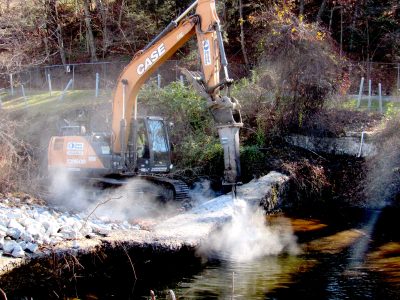Stream Waters Flow After Sprout Brook Dam Demolition in Cortlandt
News Based on facts, either observed and verified directly by the reporter, or reported and verified from knowledgeable sources.

With celebratory fanfare, local officials, environmental organizations and community members watched as a large excavator pummeled the old concrete Sprout Brook Dam last week at Sprout Brook Park in Cortlandt.
The dam’s removal last Wednesday will restore the flow of the brook and allow the migration of fish that will spawn in the brook’s fresh waters during springtime before heading to the Hudson River and out into the Atlantic Ocean.
“Five years ago, responding to a DEC (Department of Environmental Conservation) call for dam removal proposals to increase available habitat for river herring and American eel, we identified this small dam as a good candidate,” said Gareth Hougham, president of the Hudson Valley Stream Conservancy, the organization that initiated the project. “It’s the first fish migration barrier on this brook, up from the Hudson River tide and the Atlantic Ocean where the river herring live during the year.”
Hougham explained that the dam, built in the 1960s, had been unused for years, causing built-up silt and debris to impede fish migration.
“The dam removal restores aquatic habitat connectivity, natural stream flow, and improves water quality,” he said.
Climbing into the excavator cab to begin demolition was Lyndon Sams of RiverLogic Solutions, one of the agencies involved in the project. Sams analyzed the dam to see how long it would take to break down.
“This was built around 1964, and like most of these smaller dams it probably was made with rebar,” Sams said.
In less than 25 minutes the dam was breached and water gushed over chunks of discarded concrete and stones. For the first time in decades the brook flowed toward the Hudson River, just a half-mile away.
Environmental organizations and local governments involved in obtaining permits and securing grants to fund the removal included Scenic Hudson, Hudson River Programs, Hudson River Sloop Clearwater, RiverLogic Solutions, Biohabitats and the Westchester Soil and Water Conservation District. Two state Tributary Restoration and Resiliency Grants were awarded to the project by the DEC’s Hudson River Estuary Program as well as one each from the Hudson River Foundation and another from Scenic Hudson combined for nearly $250,000 to pay for the project, Hougham said.
“You can see with all the people here, it does take a village,” said Assemblywoman Dana Levenberg (D-Ossining). “These projects don’t happen on their own. They happen with incredible focus and tenacity. It’s really important that we take advantage of grant opportunities and continue to work together with all our partners.”
Cortlandt Deputy Supervisor James Creighton applauded everyone involved in the project.
“Removing an obsolete dam that serves no purpose takes a long time and this is an important project,” Creighton said. “A lot of people didn’t even know the dam existed, but with the water level so low you can actually see the top of this dam. The more we can encourage wildlife and remove the barriers to wildlife doing what it needs to do, and the more we can get out of the way the better.”
Hougham pointed out that small fish, such as river herring and eels, are a critically important food source for large ocean fish like tuna and cod.
“The big ocean fish are so important for human consumption and economies,” Hougham said. “Dams are largely responsible for small fish habitat loss and is the second most important cause of global fish population decline, second only to over-fishing in the ocean.”
For the last five years the process that led to the dam’s removal involved planning, design, engineering and permitting that meant working with the DEC, the Army Corps of Engineers and the Town of Cortlandt.
There are about 7,300 unused or abandoned dams in New York State that block fish movement, according to the DEC. American Rivers, an organization that addresses challenges facing the nation’s rivers, revealed that the United States has more than 500,000 dams; at least 60 percent are unused or unnecessary
With demolition complete, there will be restoration and replanting of the embankments, which is expected to take about two weeks.

Abby is a local journalist who has reported on breaking news for more than 20 years. She currently covers community issues in The Examiner as a full-time reporter and has written for the paper since its inception in 2007. Read more from Abby’s editor-author bio here. Read Abbys’s archived work here: https://www.theexaminernews.com/author/ab-lub2019/
